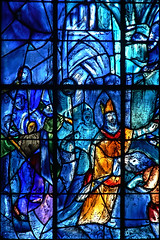Baptism 0f Clovis 496
 Traditionally, according to Gregory of Tours1 the baptism of Clovis I, king of the Franks, was around Christmas time 496 CE in Reims, represents a pivotal moment in European history. Guided by his Christian wife Clotilde and influenced by his victory at the Battle of Tolbiac, which he attributed to divine intervention, Clovis renounced his pagan beliefs and accepted Catholic Christianity. The ceremony, conducted by Bishop Remigius (Saint Rémi), also included the baptism of several thousand Frankish warriors, marking a collective conversion that extended beyond personal faith.
Traditionally, according to Gregory of Tours1 the baptism of Clovis I, king of the Franks, was around Christmas time 496 CE in Reims, represents a pivotal moment in European history. Guided by his Christian wife Clotilde and influenced by his victory at the Battle of Tolbiac, which he attributed to divine intervention, Clovis renounced his pagan beliefs and accepted Catholic Christianity. The ceremony, conducted by Bishop Remigius (Saint Rémi), also included the baptism of several thousand Frankish warriors, marking a collective conversion that extended beyond personal faith.
Modern academics, however, doubt the date given by Gregory of Tours, some also doubt that Clovis was a Pagan at the time of his baptism, thinking that he was most likely an Arian Christian. The argument being that the Franks lived close to Arian Christian kingdoms, especially the Visigoths and Burgundians. However, there’s no direct evidence that Clovis himself was ever an Arian, but the idea arises because many Germanic elites of the period were Arian Christians.2
Gregory’s goal was theological and political, he presented Clovis as a 'new Constantine', the first Catholic king among the Germanic rulers, chosen by God to defend orthodoxy against Arian heretics.3That Clovis had rejected Arianism, presenting his conversion as a triumph of Catholic orthodoxy. Since there’s no contemporary Frankish document confirming Gregory’s account, some scholars suggest Clovis may have initially sympathized with Arianism before aligning with Catholicism for political reasons. Archaeological and linguistic evidence shows that late-5th-century Frankish elites were not purely pagan, some had already adopted Christian symbols. Early Clovis’s coinage, for example, sometimes bears Christian motifs, possibly indicating earlier conection to the faith.
Whatever the truth, politically and culturally, Clovis’s baptism strengthened his alliance with the Roman Church, enhancing his legitimacy among the Gallo-Roman population and distinguishing his rule from neighboring Arian Germanic kingdoms. This event laid the foundation for the close relationship between the Frankish monarchy and the Catholic Church, fostering the rise of the Merovingian dynasty as defenders of Western Christendom4
- 1.
Early Medieval Europe, 300-1000 Palgrave History Of Europe Palgrave History Of Europe Palgrave Macmillan 2010.p109.
- 2.
Early Medieval Europe, 300-1000 Palgrave History Of Europe Palgrave History Of Europe Palgrave Macmillan 2010.p110.
- 3.
Ravenna: Capital Of Empire, Crucible Of Europe Allen Lane 2020.p79.
- 4. Citekey and shaping the future religious landscape of medieval Europe.[bib]5006:p48 not found
